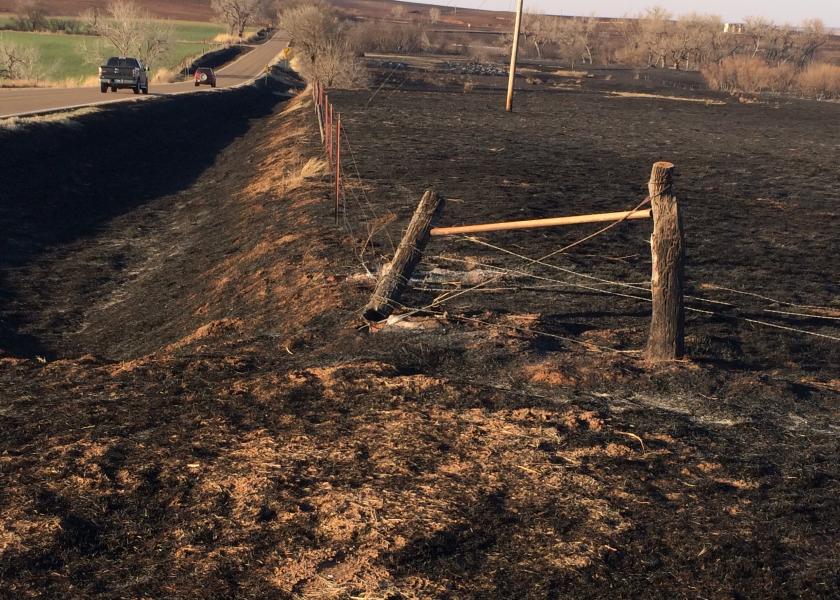Prepare Now for Livestock Disasters and Emergencies

Whether it is a wildfire, flood, tornado or an overturned truck, when disasters strike cattle operations, it can be difficult to see any “silver linings.” Beyond the bad news though, we find a couple positive outcomes. First, neighbors, friends, professional colleagues and even total strangers invariably join forces to help in any ways they can. Next, we can all learn from the experience, either directly or indirectly, and apply that knowledge to minimize the damage next time a disaster strikes.
With those outcomes in mind, a group of veterinarians and industry professionals, all with experience in livestock disasters and emergencies, joined forces to compile “Responding to Natural Disasters and Emergencies in Beef Production,” a 13-chapter guide published in the July 2018 issue of Veterinary Clinics: Food Animal Practice.
The project began after the March 2017 Starbuck Wildfire along the Kansas and Oklahoma border burned over 800,000 acres, destroying homes, fences and other facilities, killing thousands of cattle and displacing thousands more. Veterinarians Dan Thomson, at Kansas State University, Bob Smith, a consultant from Oklahoma and Christine Navarre at Louisiana State University planned the guide and identified veterinarians and industry professionals from around the country, all with direct experience in livestock disasters ranging from fires and hurricanes to blizzards and highway accidents. Dr. Smith served as consulting editor, and Drs. Thomson and Navarre served as editors and wrote the guide’s introduction.
“As we made our list of topics, we thought about our colleagues, friends, producers, and people who had expertise in these areas from firsthand experience to extensive training in food animal rescue and medicine,” Navarre and Thomson write. “Each article partners veterinarians from private practice, academia, and government organizations to bring practical, straightforward guidance on natural disasters. We are thankful for the great response and expertise that volunteered to complete this issue of Veterinary Clinics of North America: Food Animal Practice.”
Chapters and authors include:
- Preface: Responding to Natural Disasters and Emergencies in Beef Production: Dan Thomson and Christine Navarre
- Communication and Working with Authorities During Natural Disasters: Dee Ellis, Rebecca McConnico, and Jimmy Tickel
- Cattle Assessment On-Site During Emergencies: Arthur Lee Jones, Renée Dawn Dewell, and Joanna Davis
- Feeding and Watering Beef Cattle During Disasters: Justin W. Waggoner and K.C. Olson
- Tornado Preparation and Response in Feedlot Cattle: Samantha L. Boyajian, Nels N. Lindberg, and David P. Gnad
- Blizzards and Range Cattle: Management Before, During, and After the Storm: Russ Daly and Cynthia Marshall Faux
- Management of Confined Cattle in Blizzard Conditions: David B. Sjeklocha
- Wildfire Response in Range Cattle: David N. Rethorst, Randall K. Spare, and John L. Kellenberger
- Preparation and Response to Truck Accidents on Highways Involving Cattle: Lisa Pederson, Jerry Yates, and Audry Wieman
- Preparation and Response for Flooding Events in Beef Cattle: Wesley Bissett Jr, Carla Huston, and Christine B. Navarre
- Managing Heat Stress Episodes in Confined Cattle: Kevin F. Sullivan and Terry L. Mader
- Foreign Animal Disease Outbreaks: Danelle A. Bickett-Weddle, Michael W. Sanderson, and Elizabeth J. Parker
- Humane Euthanasia and Carcass Disposal: Jan K. Shearer, Dee Griffin, and Scott E. Cotton
- Mental Health During Environmental Crisis and Mass Incident Disasters: Erin Wasson and Audry Wieman
In Livestock Disasters and Emergencies, quick decisions, coordination and teamwork are critical. This guide draws on first-hand experiences of the contributing authors, along with their expertise in veterinary medicine, cattle management and animal welfare to enhance preparation, response and overall outcomes.
Learn more or subscribe for access from Veterinary Clinics: Food Animal Practice.







